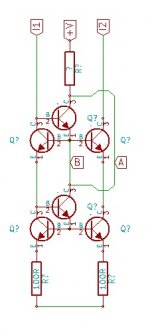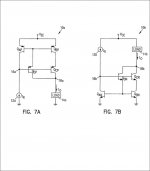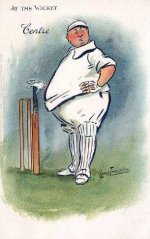To the Jeff and the rest of the gang................
Attachments
Last edited:
And I just put too much faith in the 2SJ109s I already have in a drawer. 😉
Happy Holidays everyone!
Happy Holidays everyone!
..total harmonic structure including the higher orders are of more siginificant value.
So are you having Christmas in the States? Wishing you a great Christmas.🙂
1) All easily taken care of. I did say we are anal. Hahaha
2) Yeah spending Christmas here. When I get back home I will get back into building.
Hope you have a great a Christmas too.
It’s already Christmas in Australia, so Merry Christmas Jam.
Last edited:
I was looking at other CFA topologies similar to SixPack and found Knut Harald Nygaard's version (Power Amplifier, https://www.andiha.no/articles/audio/powerfig/klassea1.gif).
He uses a Sziklai pair for each side of his push/pull VAS. Is this just to allow the VAS to swing closer to the rails than a Darlington could, or does it have other advantages?
Note: just curious; I'm not considering yet-another-topology. 😉
Cheers,
Jeff.
He uses a Sziklai pair for each side of his push/pull VAS. Is this just to allow the VAS to swing closer to the rails than a Darlington could, or does it have other advantages?
Note: just curious; I'm not considering yet-another-topology. 😉
Cheers,
Jeff.
You can get lower output impedance with sziklai pair but this may or may not be of significant benefit for VAS, it kind of depends what the VAS is driving.
Often having too much bandwidth is the problem so having a VAS with low output impedance is probably not that beneficial, it all just depends.
Having sziklai pair on output stage would probably make most sense, but I personally prefer just using mosfets on output.
Often having too much bandwidth is the problem so having a VAS with low output impedance is probably not that beneficial, it all just depends.
Having sziklai pair on output stage would probably make most sense, but I personally prefer just using mosfets on output.
Last edited:
I just looked at the circuit, and am thinking this might be useful for other reasons the brain hasn't processed yet.
Normally sziklai pair is used to replace a source follower (common drain, common collector) stage, I haven't seen it used for voltage amplification.
Maybe they want less open loop gain.
Normally sziklai pair is used to replace a source follower (common drain, common collector) stage, I haven't seen it used for voltage amplification.
Maybe they want less open loop gain.
Last edited:
You could ask Knut Harald what is the benefit of grounding the junction of the two 5.6K emitter resistors (R23 R24). Why not let that node rise and fall?
Aaah they have flipped it, for common emitter not common collector.
Oh my brain is hurting. Hahahaha
Just making some guesses.
I don't read text books.
Hahahaha
I don't see getting improved voltage swing as being the reason, it is insignificant.
There are other more significant benefits to sziklai if properly utilised.
Oh my brain is hurting. Hahahaha
Just making some guesses.
I don't read text books.
Hahahaha
I don't see getting improved voltage swing as being the reason, it is insignificant.
There are other more significant benefits to sziklai if properly utilised.
Last edited:
He he, maybe I should have read the text I linked to. 😉
And, in the very next paragraph, the answer to Mark's query:Instead of using an ordinary current mirror for the current from Q9/Q10, here is used an amplifying current mirror. The voltage on the input of the amplifier is transformed to a proportional current in the JFETs. This current is compared to the feedback current (via R14). The resulting error current is transformed to a voltage across R7 (and R8). This error voltage is found across R19 (and R20) with little degradation, since Q16 (and Q17) operates with constant current (and with that constant base-emitter voltage). The error current is amplified as the relation given by R7/R19 (and R8/R20), and is transformed to a proportional voltage in the summing point before the current amplifier.
The open loop gain is given by the JFET's transconductance reduced with local feedback, multiplied with the relation R7/R19 and finally multiplied with the double load on the base of Q31/Q32. Without the resistors R23 and R24 the load at this point is both load dependent and parameter dependent. Thus these resistors determine the open loop gain to about 46 dB. With a closed loop gain at about 26 dB, the feedback factor is relatively low: about 20 dB.
The Sziklai pair can have stability problems when used in an output stage but is commonly used in small British integrated amplifiers. Used in a current sourced Vas it can work great but sometimes needs to degenerated for stability but I do not recommend for use in a complementary circuit. That being said a Sziklai can have better thermal stability.
Knut Harlans talks about their use in class amplifiers..
Class A amplifiers
Most modern designs (especially high powered units) stay away from the use of Sziklai output stage. The problem being some intrinsic differences between the top and bottom halves of the circuit. I usually leave Sziklai out of my designs except for their use in single ended buffers.
Maybe I just don't like nested feedback loops.😛
Just my humble opinion.
Jam
Knut Harlans talks about their use in class amplifiers..
Class A amplifiers
Most modern designs (especially high powered units) stay away from the use of Sziklai output stage. The problem being some intrinsic differences between the top and bottom halves of the circuit. I usually leave Sziklai out of my designs except for their use in single ended buffers.
Maybe I just don't like nested feedback loops.😛
Just my humble opinion.
Jam
Last edited:
The simple current mirror has an Ib error which is corrected in the improved mirror.
The cascoded mirror is two simple mirrors stacked; if I wanted to address the Ib error issue in the cascoded, I assume connection A is is the way it should be wired, my question is, would connection B work or would it introduce it's own problems?
Sorry for the dumb question, I'm still not spice compatible 🙁
The cascoded mirror is two simple mirrors stacked; if I wanted to address the Ib error issue in the cascoded, I assume connection A is is the way it should be wired, my question is, would connection B work or would it introduce it's own problems?
Sorry for the dumb question, I'm still not spice compatible 🙁
Attachments
I am not spice compliant either 😀...have to get my friend Mark to help me.
This patent should answer your questions.
US5283537A - Current mirror circuit
- Google Patents
...but close observation it is just a cascoded current mirror with early effect correction, which has the problem of reduced voltage swing I posted earlier in the thread .........there is a possible solution.....think in reverse.....🙂
Jam
This patent should answer your questions.
US5283537A - Current mirror circuit
- Google Patents
...but close observation it is just a cascoded current mirror with early effect correction, which has the problem of reduced voltage swing I posted earlier in the thread .........there is a possible solution.....think in reverse.....🙂
Jam
Last edited:
....pico, thinking of home? 😀
Attachments
Last edited:
This patent should answer your questions.
Thank you Jam, Figure 6 confirms connection A.
...which has the problem of reduced voltage swing...
I'm not worried about losing a couple of volts over the mirror, I can just crank the supply if I need to.
I like the folded cascode idea, I'm still still chewing it over, it takes a while with only half a brain cell. These days it's mostly on the fritz!
I'll add the other mirror to the list to try 🙂
You said folded cascode.............you should see the pre-amp I am designing for use with this power amp....hopefully I can get pico to contribute his regulator.😀
Jam
Jam
Attachments
Last edited:
- Home
- Amplifiers
- Pass Labs
- JamJar: an HPA-1-inspired power amp












